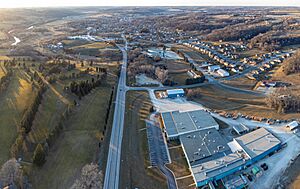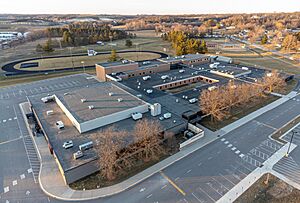Chatfield, Minnesota facts for kids
Quick facts for kids
Chatfield
|
|
|---|---|

US-52 runs through town
|
|
| Motto(s):
"The Gateway to Bluff Country" and "The Chosen Valley"
|
|

Location of Chatfield, Minnesota (Olmsted County)
|
|

Location of Chatfield, Minnesota (Fillmore County)
|
|
| Country | United States |
| State | Minnesota |
| Counties | Fillmore, Olmsted |
| Area | |
| • Total | 2.59 sq mi (6.71 km2) |
| • Land | 2.59 sq mi (6.71 km2) |
| • Water | 0.00 sq mi (0.00 km2) |
| Elevation | 1,034 ft (315 m) |
| Population
(2020)
|
|
| • Total | 2,997 |
| • Density | 1,157.59/sq mi (446.89/km2) |
| Time zone | UTC-6 (Central (CST)) |
| • Summer (DST) | UTC-5 (CDT) |
| ZIP code |
55923
|
| Area code(s) | 507 |
| FIPS code | 27-11008 |
| GNIS feature ID | 2393810 |
Chatfield is a small city in the state of Minnesota, USA. It is special because it sits in two different counties: Fillmore and Olmsted. In 2020, about 2,997 people lived there.
Chatfield is often called "The Gateway to Bluff Country" because of its beautiful landscape. It's also known as "The Chosen Valley," a nickname it earned long ago.
Contents
History of Chatfield
Chatfield was named after Judge Andrew G. Chatfield. The city was started in 1853 by a person named Andrew Twiford.
At first, Chatfield was the main town, or "county seat," for Fillmore County. Many of the first people to settle here came from New England, a region in the northeastern United States. They built a very successful community. This success led to the nickname "the Chosen Valley."
During the American Civil War, a group from Chatfield called the Chatfield Guards became famous. They were part of the 2nd Minnesota Volunteer Infantry. Their leader, Captain Judson W. Bishop, later became a colonel and led the whole regiment.
Geography and Nature
Chatfield covers about 2.64 square miles (6.71 square kilometers) of land. It has a unique feature: the only stop light in all of Fillmore County is located here! You can find it at the crossing of 3rd Street and Main Street.
Two important waterways flow through or near Chatfield. One is the North Branch of the Root River. The other is Mill Creek, which is a special stream known for its trout fish.
Several main roads pass through the city. These include U.S. Highway 52, State Highway 30, State Highway 74, and Fillmore County Road 2. These roads help people travel in and out of Chatfield.
Population Changes
| Historical population | |||
|---|---|---|---|
| Census | Pop. | %± | |
| 1880 | 9,001 | — | |
| 1890 | 1,335 | −85.2% | |
| 1900 | 1,426 | 6.8% | |
| 1910 | 1,228 | −13.9% | |
| 1920 | 1,382 | 12.5% | |
| 1930 | 1,269 | −8.2% | |
| 1940 | 1,640 | 29.2% | |
| 1950 | 1,605 | −2.1% | |
| 1960 | 1,841 | 14.7% | |
| 1970 | 1,885 | 2.4% | |
| 1980 | 2,055 | 9.0% | |
| 1990 | 2,226 | 8.3% | |
| 2000 | 2,394 | 7.5% | |
| 2010 | 2,779 | 16.1% | |
| 2020 | 2,997 | 7.8% | |
| U.S. Decennial Census | |||
The population of Chatfield has grown over the years. In 2010, there were 2,779 people living in the city. By 2020, the population had increased to 2,997.
Many different types of families and individuals live in Chatfield. About 28.6% of the people living there are under 18 years old. The average age in the city is about 36.9 years.
Education
Chatfield has its own high school, Chatfield High School. It helps students learn and grow in the community.
Fun Things to Do
Chatfield offers several fun activities and places to visit:
- Western Days: Every year, on the second weekend of August, the town celebrates "Western Days." It's a special event for everyone to enjoy.
- Chatfield Brass Band Music Lending Library: This unique library keeps and shares old sheet music from the time when brass bands were very popular. It's a great place for music lovers.
- Chatfield Center for the Arts: Here, you can enjoy live music, see art exhibits, and watch theater performances. The Potter Auditorium, a part of the center, was updated in 2016.
- Pope & Young Museum of Bowhunting: This museum opened in Chatfield in 2004. It's dedicated to the history and sport of bowhunting.
Famous People
- Josef Fahrenholtz (born 2001), a professional basketball player, is from Chatfield.
Gallery
See also
 In Spanish: Chatfield (Minnesota) para niños
In Spanish: Chatfield (Minnesota) para niños







